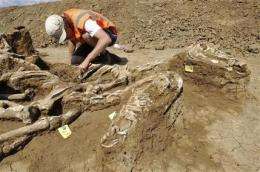Unusual 17th-century Dutch horse burial site found

(AP) -- Archeologists have uncovered a mass grave with the complete skeletons of 51 horses buried side-by-side, probably the long-forgotten equine victims of a 17th century battle over a strategic Dutch river.
It was the largest known equine burial ground in Europe, although chief archaeologist Angela Simons said Wednesday that many such sites have probably existed and have been plowed up over the centuries by unwitting farmers.
The archaeological team had been looking for evidence of prehistoric human settlements in the area when they came across the unexpected find.
"From the first shovel, it was horses, horses and more horses," said Angela Simons, of the Hazenberg company, which was employed by the Dutch government to survey the ground ahead of a construction project.
The horses showed signs of being buried quickly: their bodies were not carefully arranged, and the skeletons occasionally overlap.
"It's easy to imagine this is how cavalry men might dispose of dead mounts in war time," Simons said. Disease or a plague could not be ruled out.
It also was unclear whether the horses were buried out of respect, or because of the fear of contamination from so many decomposing corpses.
The skeletons were in a ditch in a field near the Maas River in Borgharen, around 2 miles (3 kilometers) north of the Dutch border city of Maastricht.
Initial carbon testing dated the bones to the 17th century, when the Netherlands was still struggling to emerge as a nation.
If the horses were killed in a battle, likely candidates include a fight in 1632 during the Eighty Years' War, when Dutch rebels quartered in Borgharen repelled a surprise charge by the Spanish cavalry.
Another possibility is the 1673 siege of Maastricht by soldiers of French "Sun King" Louis XIV. That battle is considered a milestone in siege warfare, because of how the attacking French used zigzagging ditches to give their soldiers cover from the city's battlements.
Both engagements were fought during the summer.
No traces of bridles or saddles were found in the shallow 130-foot (40-meter) -long grave, suggesting they were removed. The researchers discovered just one stirrup and several horseshoes.
One horse had a bullet in its skull just behind the eye-socket, probably an injured horse shot to prevent further suffering, Simons said.
Evidence suggests they were cavalry horses. Most appeared to be around 4 years old, and their size and bone structure suggests they were for riding, not draft horses.
Simons, who is German, said it was possible the animals had some connection with several French soldiers whose skeletons were uncovered on a riverbank in Borgharen in 2004. The human skeletons were identified as French from their coat buttons.
©2010 The Associated Press. All rights reserved. This material may not be published, broadcast, rewritten or redistributed.


















